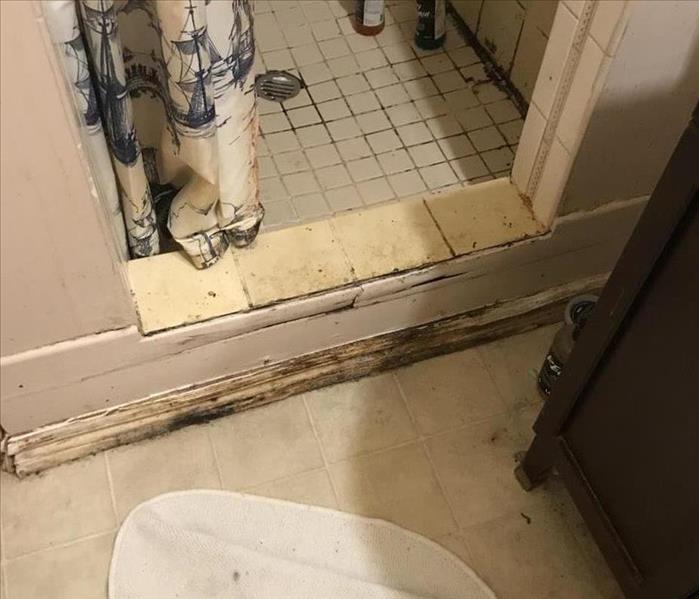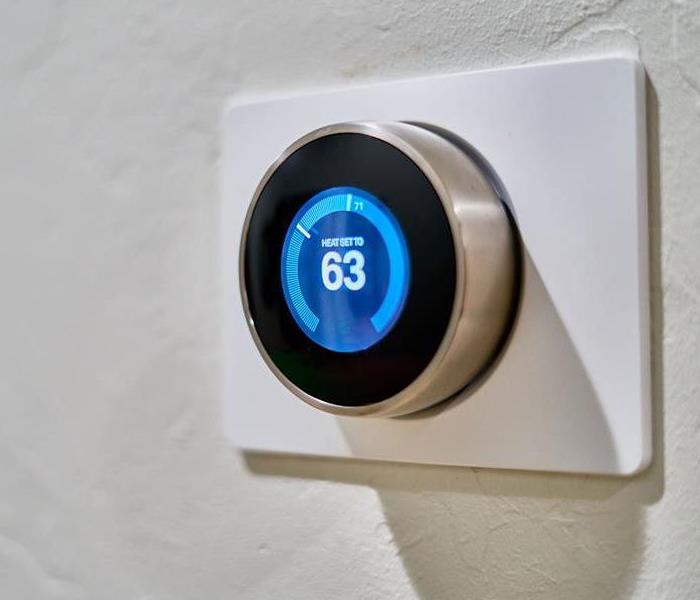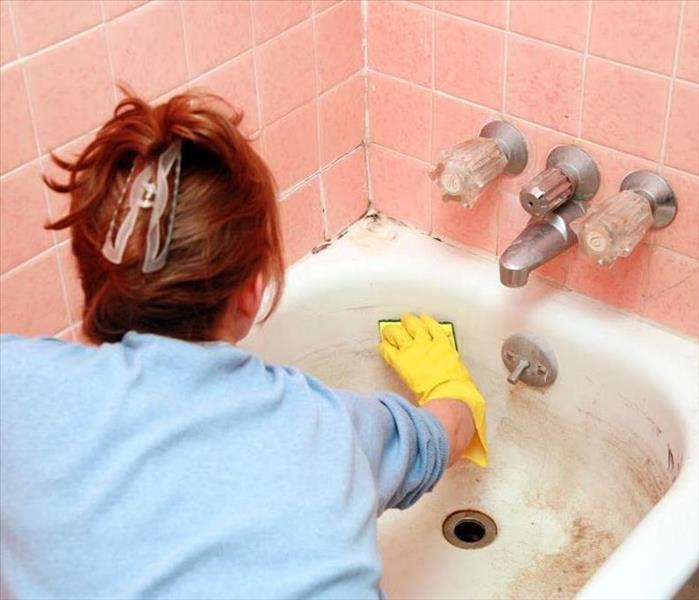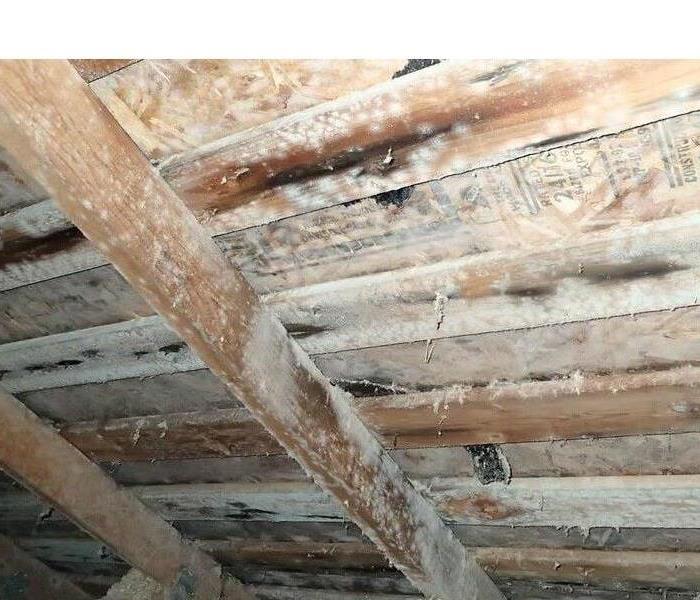Recent Mould Remediation Posts
Can Properties in Mississauga Experience Mould Damage? SERVPRO Says--Call Us for Remediation
3/28/2020 (Permalink)
 Why Let Mould Rule Your Mississauga Home? SERVPRO Has the Remedies--"Like it never even happened."
Why Let Mould Rule Your Mississauga Home? SERVPRO Has the Remedies--"Like it never even happened."
Risks of Mould and What SERVPRO Can Do for Mississauga Homes
Moist conditions can feel difficult to avoid in Mississauga homes and businesses, especially with the proximity to larger bodies of water and higher humidity levels throughout the year. Higher moisture content in the air can provide the right conditions for mould growth and development without the appropriate regulation of the humidity. The discovery of mold growth can be alarming, mainly when the problem has spread to multiple surfaces before you notice.
Our SERVPRO professionals have seen the effects of mold damage in Mississauga firsthand and have the appropriate training and equipment to handle these threats as they get found. Remediation practices can help to not only slow the spread and severity of these conditions but remove active colonization and better protect your structure and its occupants. Whether it is your family home or business like an office or restaurant, there are risks associated with direct and prolonged exposure to mold colonies.
Immediate Threats of Mould Development
Knowing what to expect from the development of mold colonies and the spread of the organism throughout your structure is beneficial to appreciate the need for remediation to begin right away. Many homeowners mistakenly believe that living with mold is neither hazardous nor uncommon, and consequently, do little to combat this spreading threat in their house. There are multiple hazards to active mold growth and colonization, all of which can have swift and direct effects on your property and its occupants.
Health Effects
There is no mistaking that direct exposure to mold colonization has gotten linked to detrimental health effects. A higher concentration of mould spores can be hazardous in itself. However, active colonies can also produce volatile organic compounds (VOC) from the organism feeding on organic matter and spreading to new surfaces. VOCs are toxic and vary in degrees of severity based on how concentrated exposure becomes.
Material Degradation
Colonies use materials as hosts for the organism and feed on the matter of these organic structural elements and contents of a residence to thrive. With every passing day where mould goes unchallenged in these hosting materials, surfaces like drywall, flooring, ceilings, and contents weaken and decay.
Experienced Technicians to Help
By the time that you realise that the organism has taken root in rooms of your home or office, remediation is a necessary step that must occur to protect what you still can in the structure. Our SERVPRO team can help by providing your Mississauga property qualified and accredited Applied Microbial Remediation Technicians (AMRT) endorsed and trained by the Institute of Inspection, Cleaning and Restoration Certification (IICRC.) These professionals continue to train and grow their knowledge of this industry niche to provide confident and efficient recovery options for customers. Many of these same technicians have base certifications in Water Restoration (WRT) and Applied Structural Drying (ASD) to provide even more effective long-term solutions for the property moving forward.
Mold Removal Vs. Mold Remediation
You might have noticed that there are plenty of restoration teams out there claiming that they can remove all the mould in your home or office. Removing all mold spores from any environment is impossible and damaging because, in most cases, the presence of spores is a benefit to the environments where they get found. It is when moist conditions exist, and the number of spores amplifies to unmanageable levels that it becomes a threat that can produce mold colonies. Removing all of the spores in a structure is likely impossible, and if it were feasible, it would be an unnecessary and exceptionally high expenditure.
Remediation, on the other hand, is a system that seeks to address the threats of active mould colonization and migration through the house. With varying approaches, we can remove colonies from their hosting materials to eliminate higher concentrations of mold spores and potential VOCs that can lead to health effects for those exposed.
Remediation to Remove Active Colonization
Not every Mississauga home experiences mould damages in the same way. Therefore, the approach for restoring these materials and areas varies as well. Remediation is a process full of countless decisions that can change by the day to ensure that the appropriate drying occurs, the right containment barriers are in place, and that progress is getting made on removing active colonies to get families back into their home as quickly as possible.
Abrasive Cleaning
Many susceptible surfaces can host mould organisms but do not instantly become too damaged to preserve. In many cases, media blasting can be a suitable solution to remove active colonization without damaging the substrate of the hosting material. Baking soda is a common choice in this approach, as this pressurized cleaning can also help to reduce musty odors that fungal organisms can produce.
Antimicrobial Agents
Treating surfaces lightly or potentially affected by spreading spores can eliminate developing colonies on the top layer before the organism can seat into the construction material. Antimicrobial products can remove most microorganisms present on the surface of structural faces or contents in the house.
Removing Affected Materials
In some ways, the only suitable solution for removing the present mould colonies penetrating porous materials in your home or business is to rely on our SERVPRO contractors. We have in-house residential and commercial contractors experienced in building trades to complete controlled demolition and discarding damaged materials to remediate colonization on overly compromised structural elements effectively.
Rebuilding After Mould Damage
These same contractors that performed controlled demolition in the mitigation stages of remediation for your Mississauga property can help with full-scale build back where it is necessary. A seamless transition between remediation and cleaning to reconstruction can save you time and money on the work your structure needs.
Mould damage is one of the few disasters that you might not instantly recognize, so when you do, the situation can feel overwhelming. Our experienced SERVPRO of North Mississauga AMRTs can arrive quickly with the tools and products to make a difference quickly. No matter what it takes to make mould damage, “Like it never even happened,” our professionals can help when you call (905) 238-7376.
How to Prevent Mold in HVAC Units in Toronto
1/2/2020 (Permalink)
 HVAC Mold Prevention in your Toronto, Ontario home.
HVAC Mold Prevention in your Toronto, Ontario home.
Preventative measures to ensure that you keep your Toronto home HVAC unit mold free.
Mold is a very dangerous substance. Often known as the “silent killer”, it has torn the lives and health apart for countless people. That’s why it’s important to know what mold is, what it needs to grow, and how to prevent it. One place that mold seems to love to grow that can lead to devastating consequences is in the HVAC system, otherwise known as your cooling and heating system. This can happen to literally anyone with this type of system, which is why you should work to prevent it from happening. Read on and we’ll tell you exactly how to prevent mold in HVAC units.
Where Mold Loves to Grow
Mold is a fungus that is made up of small organisms that are found almost everywhere. All it takes is a little moisture, some organic matter, and the right temperature and mold growth can run rampant. Unfortunately, this is exactly the type of environment that can be found within your HVAC system.
That’s why, in order to prevent mold in HVAC units, you must regularly maintain it and ensure its proper functioning. On top of that, you have to make sure your HVAC system stays dry, free of particles, and clean. Keep reading to learn more about how to prevent mold in HVAC units.
How to Prevent Mold in HVAC Units
Preventing mold in your HVAC system is easier than you might think. It just requires proper cleaning, maintenance, and functioning. As long as you are having your system checked annually and it’s working correctly, you only need to worry about the cleaning part. Follow these three steps to keep your HVAC system clean and free of mold:
1. Keep Moisture Out
Make sure to properly maintain and clean the drain pans in the unit. If the drain pans are not cleaned they could get clogged and lead to standing water which can grow mold.
2. Disinfect & Use Mold Inhibitors
It can be a good idea to disinfect the HVAC system and then use a mold inhibitor. These inhibitors can prevent mold and mildew from forming in the unit.
3. Replace Air Filters Often
When it’s time to change the air filter, don’t put it off! If your air filter is dirty it won’t be able to trap mold spores and other contaminants.
If you do need to call a Mold Remediation company, call our expert mitigation team at SERVPRO of North Mississauga.
Click here for more information on Toronto
Is Your Bathroom Causing Mould To Grow?
12/18/2019 (Permalink)
 SERVPRO has the right techniques to get rid of bathroom mould out of your Mississauga home
SERVPRO has the right techniques to get rid of bathroom mould out of your Mississauga home
6 Tips on Effectively Preventing Mould Growth in Your Bathrooms
Mould growth in bathrooms is a common but a pesky problem, irrespective of whether you are a renter or owner. It is a given that bathrooms will be generally humid and accumulate moisture. However, improper ventilation can often lead to mould formation, which further damages the walls and the ceilings. Additionally, mould allergies are a common cause of health issues. Thus, it is essential to tackle and prevent mould growth from happening in your bathrooms.
The good news is that with regular and proper care and maintenance it is possible to handle any mould growth problems that you might face. Here are 6 useful tips on how to prevent mould growth in bathrooms, along with things that you must watch out for.
1. Check the exhaust fan
The most important thing that every bathroom should have is a properly functioning and effective exhaust fan. The fan is instrumental in reducing the moisture content in the bathroom, especially after people shower in them.
Take proper care to position the fan above or near the shower area for maximum results. Care should also be taken to ensure that the fan is cleaned periodically. Make it a habit to switch on the fan whenever showering and leave it on for at least 30 minutes after. Many people opt to hardwire the exhaust with the bathroom lights to ensure that it gets switched on.
Another important aspect of an effective exhaust fan is its capability of performing around 15 air changes per hour. Calculate your bathroom's cubic volume and multiply this number by 15. For example, an exhaust fan with a capability of 480 cubic metres is sufficient for a bathroom sized 4 metres by 4 metres by 2 metres (4 x 4 x 2= 32 cubic metres; 32x15= 480 cubic metres). If in doubt, check with the fan's manufacturers for the exact capacity.
2. Remove additional moisture
It is tempting to ignore this step, especially when in a hurry. However, just leaving the exhaust fan switched on is not sufficient to handle moisture. Use a squeegee to remove all the excess water from the showering area. If you find water has accumulated on the surrounding walls, you can use an absorbent cloth, like microfiber to wipe down the surfaces. This additional step will go a long way in preventing mould from growing.
3. Watch out for any leaks
Keep an eye out for any cracks or leaks in the wall, ceiling or the floors. Leaks are susceptible to mould growth and hence must be repaired as soon as noticed. Do not leave them to be fixed at a later date. If you find that you cannot fix it by yourself, do not hesitate to call a plumber and get the job done.
After all, a stitch in time saves nine.
4. Wash your towels and rugs
As you can well imagine, damp towels, rugs and other linens like the shower curtain in the bathroom are the breeding place for moulds. Hence, make sure to wash your towels and rugs regularly. Opt for bathroom rugs that are machine washable so that cleaning them is easier for you. A good practice is to clean these items once a week.
5. Dry the shower products
Other spots that are vulnerable to mould growth are the shower items like sponges and loofahs. Once you are done using them, make sure to air dry them in a well-ventilated spot. Otherwise, moisture can accumulate in these products and allow mould growth to take place. Drying them properly is essential for hygiene purposes.
6. Open the windows
If your bathroom is equipped with a window, then it is good practice to open it occasionally to let the room air out. There is nothing as effective as natural ventilation if you are lucky to have it.
At SERVPRO of North Mississauga, we understand how problems like mould growth can negatively impact the lives of our customers. Our professional experts are experienced at handling both commercial and residential property damage restorations, including mould growth.
Contact us today to learn more about our services and how we can help you with your property restoration needs.
What You Should Do if You Find Mould in Your House
11/30/2019 (Permalink)
 White Mould Growth
White Mould Growth
It can be every homeowner’s worst nightmare… mould. Known as the silent killer, mould can affect your health in negative ways without you even knowing it. While it can be a terrible feeling and experience to find it growing in your home, you should at least be happy that you found it. But what happens next? Here we will tell you what to do if you find it in your house.
How to Tell if it is Mould
The first thing to know is that mould likes dark areas that don’t get a lot of airflow and/or are exposed to any sort of moisture. Mould can also occur where food is prepared like in the kitchen. Bathrooms are a common area for microbial growth due to the moisture present. A leaky roof in the attic can also be causing possible growth you’re not aware of.
Mould is usually fuzzy and black or green in color. It can also appear in small green, black, and white patches. If the area is damp at all, that is also a sure indication.
What to Do if You Find Mould in Your House
If you find any growing in your home, the first thing you should do is be careful not to disturb it. By touching it or trying to wipe it off, for example, you can actually release toxic spores into the air instead. This can, in turn, spread through the air conditioning and infect other places of the home.
While using bleach is a common remedy, it is important to note that it can only work in certain cases. Bleach can only be used to kill mould that is on non-porous surfaces such as tile or glass. If there is growth on any porous surface such as wood or drywall, a professional should be called in.
Some online guides suggest cutting the area out, like with drywall, and just replacing it. However, once you can see microbial growth, it’s possible there is potential contamination in other places and a microscopic leak could even be to blame. Therefore, if you spot anything that looks suspicious anywhere in your home, you should call out professionals who can assess and start the mould remediation process promptly.
SERVPRO® of North Mississauga specializes in mould remediation. We use specialized equipment and techniques to thoroughly clean and resolve your problem quickly and safely. The safety and health of you and your family are our biggest concern. If you have mould in your home or business, give SERVPRO® of North Mississauga a call at 905.238.7376

 24/7 Emergency Service
24/7 Emergency Service


